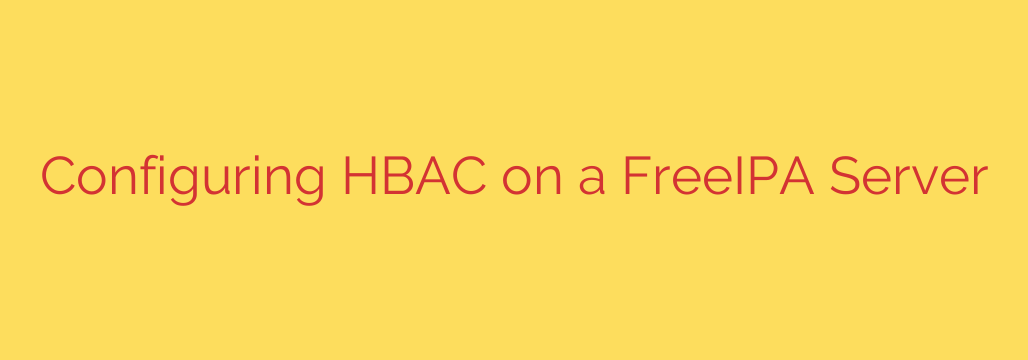
Effectively managing who can access what on your servers is paramount for security. In a FreeIPA environment, this control is primarily handled through HBAC (Host-Based Access Control) rules. HBAC allows administrators to define precise policies specifying which users or groups are permitted to use particular services on specific hosts or host groups. Understanding and configuring these rules correctly is fundamental to securing your infrastructure.
An HBAC rule acts like a permission statement. It connects three key components:
- A principal: This is typically a user or a group of users.
- A target host: This is the host or a host group where the access is being requested.
- A service: This is the specific service the principal wants to access on the target host (e.g.,
ssh,login,sudo).
If a user attempts to access a service on a host, FreeIPA checks the defined HBAC rules. If a rule matches the user/group, host/host group, and service, and the rule is enabled, access is granted. If no matching rule is found, access is typically denied (depending on default policies).
You can configure HBAC rules using two main methods in FreeIPA: the command-line interface (ipa command) and the Web UI.
Configuring HBAC via the Command Line
The ipa hbacrule command is your primary tool for managing HBAC rules programmatically.
Creating a New Rule:
To start, you need to create an empty rule and give it a descriptive name.ipa hbacrule-add rule_name --description="Description of this rule's purpose"Replace
rule_namewith something meaningful likeallow_developers_on_dev_servers.Adding Users or Groups to the Rule:
Specify who this rule applies to. You can add individual users or entire groups.ipa hbacrule-add-user --hbac-rule=rule_name --user=usernameipa hbacrule-add-group --hbac-rule=rule_name --group=groupnameYou can add multiple users and groups to the same rule by repeating the command or listing them separated by commas.
Adding Hosts or Host Groups to the Rule:
Specify where this rule applies. You can add specific hosts or host groups.ipa hbacrule-add-host --hbac-rule=rule_name --host=hostnameipa hbacrule-add-host --hbac-rule=rule_name --hostgroup=hostgroupnameTo apply the rule to all hosts managed by FreeIPA, use
--hostcat=all.Adding Services to the Rule:
Specify what service this rule applies to. Common services includessh,login,sudo, etc.ipa hbacrule-add-service --hbac-rule=rule_name --service=servicenameTo apply the rule to all services, use
--servicecat=all.Viewing HBAC Rules:
To see the details of a specific rule:ipa hbacrule-show rule_nameTo list all configured HBAC rules:
ipa hbacrule-findEnabling and Disabling Rules:
By default, new rules are enabled. You can toggle their status:ipa hbacrule-enable rule_nameipa hbacrule-disable rule_nameDeleting a Rule:
To remove a rule entirely (be careful, this immediately affects access):
bash
ipa hbacrule-del rule_name
Configuring HBAC via the Web UI
The FreeIPA Web UI provides a graphical way to manage HBAC rules, which many administrators find easier for visualization and quick edits.
Navigate to the Identity section and select HBAC Rules. Here, you can:
- Click +Add to create a new rule.
- Click on an existing rule name to view its details and click Edit to modify its users, hosts, or services.
- Use the checkboxes to select rules and the Enable, Disable, or Delete buttons.
The Web UI presents the same options as the command line but in a point-and-click interface.
Important Considerations
- Default Rules: FreeIPA often comes with a default
allow_allrule. For better security, it’s best practice to disable this rule once you have created specific rules that grant necessary access. - Specificity: Create rules that are as specific as needed. Avoid overly broad rules unless truly necessary (like allowing administrators full access).
- Testing: Always test your HBAC rule changes to ensure they have the intended effect and don’t accidentally lock users out or grant unintended access.
By mastering HBAC configuration in FreeIPA, you gain fine-grained control over access permissions, significantly enhancing the security posture of your identity management system and the servers it controls. Careful planning and implementation of your HBAC rules are crucial steps in building a robust and secure environment.
Source: https://kifarunix.com/configure-host-based-access-control-on-freeipa-server/








